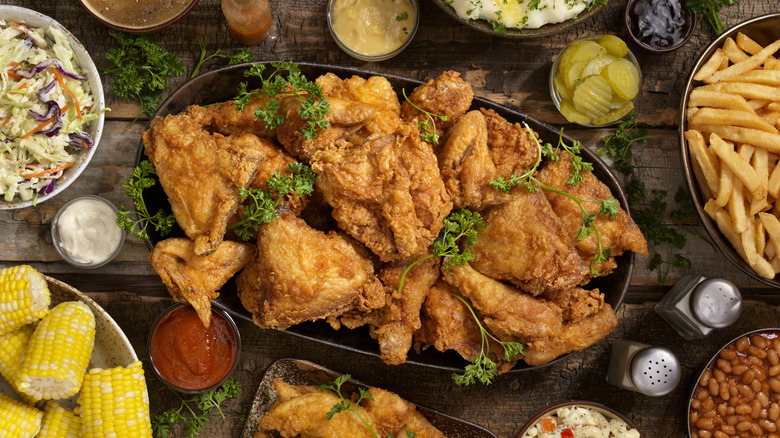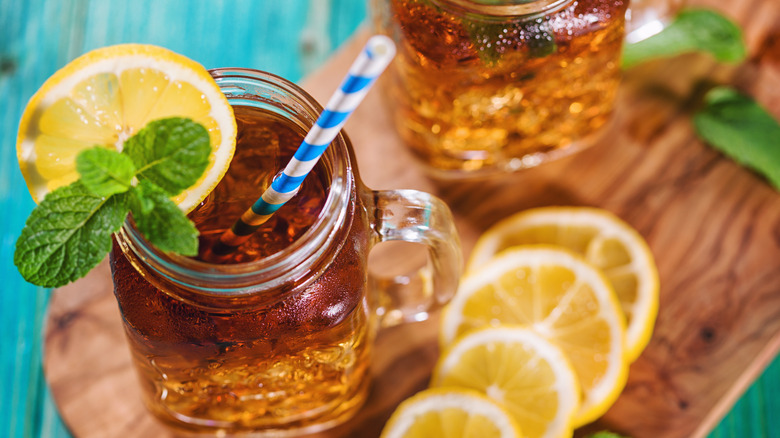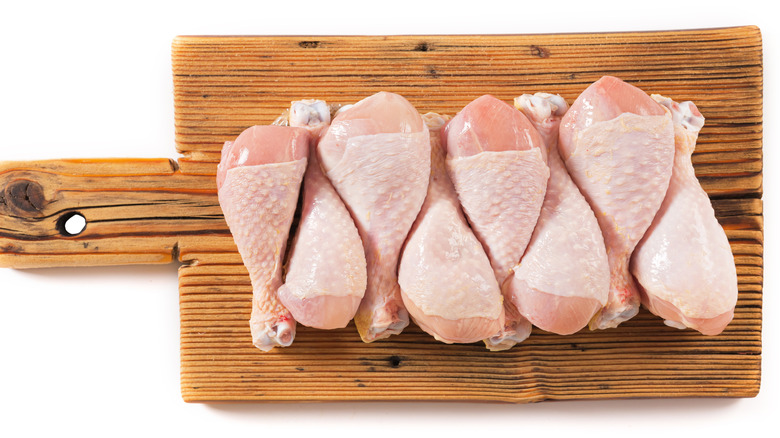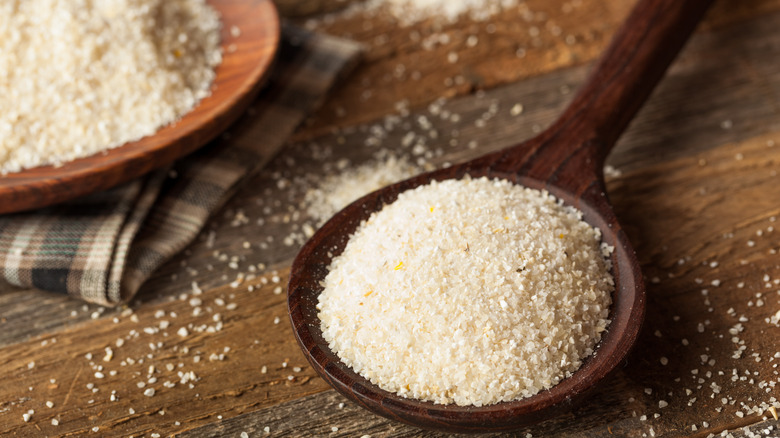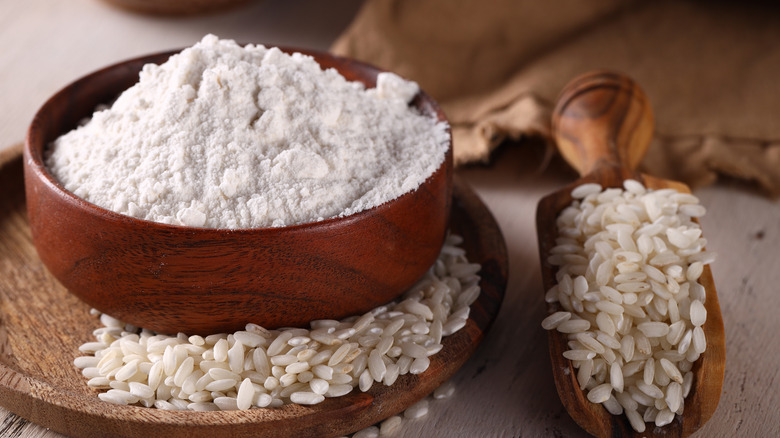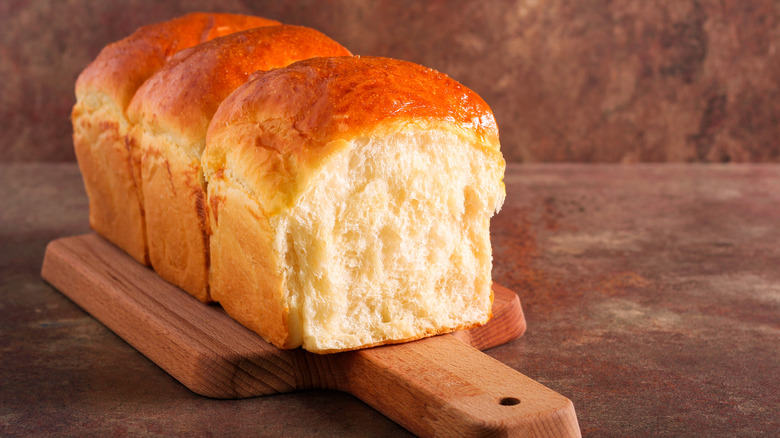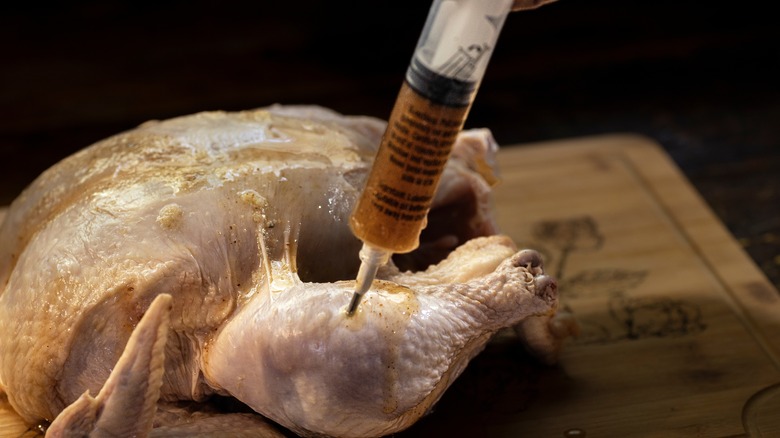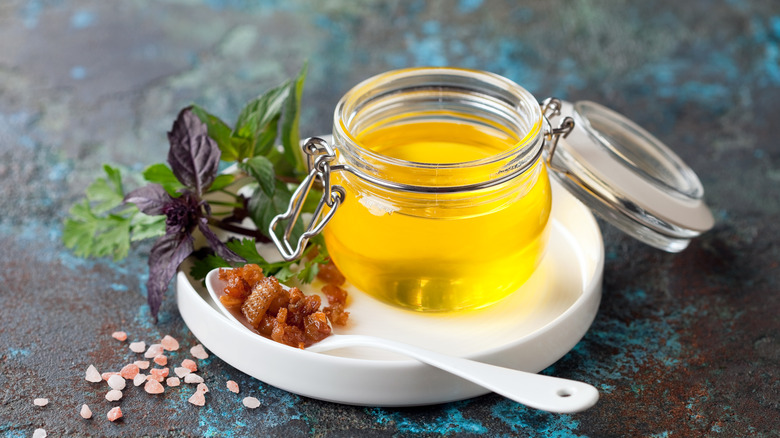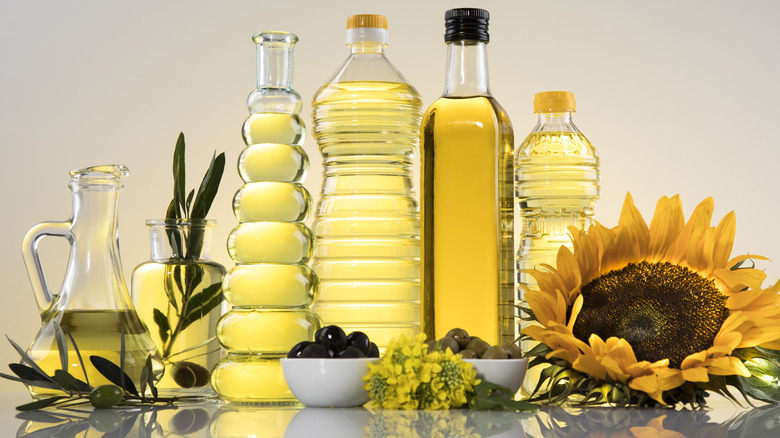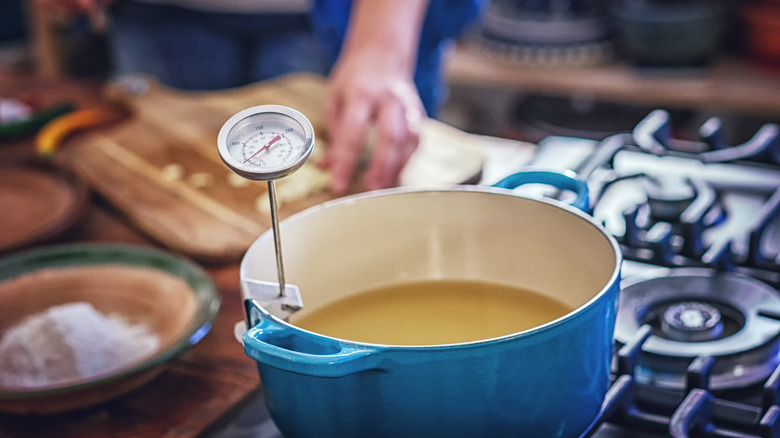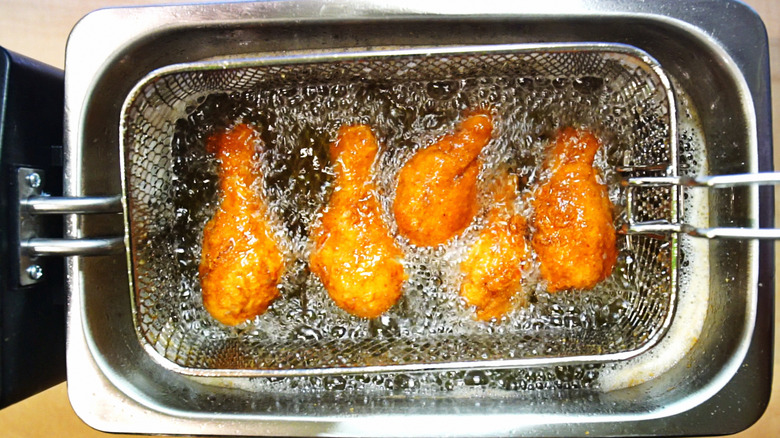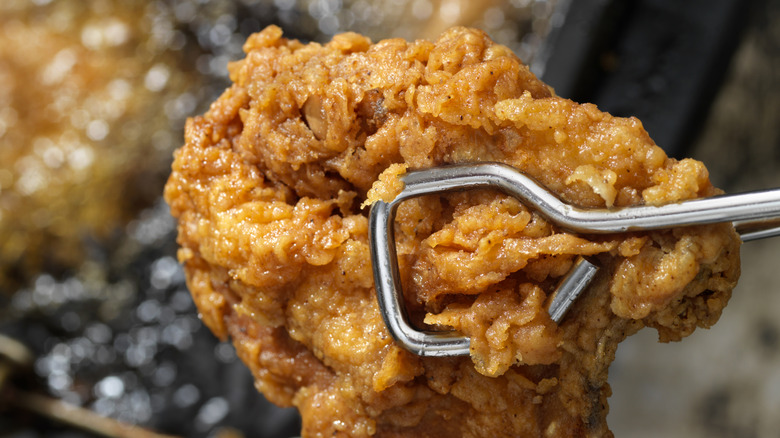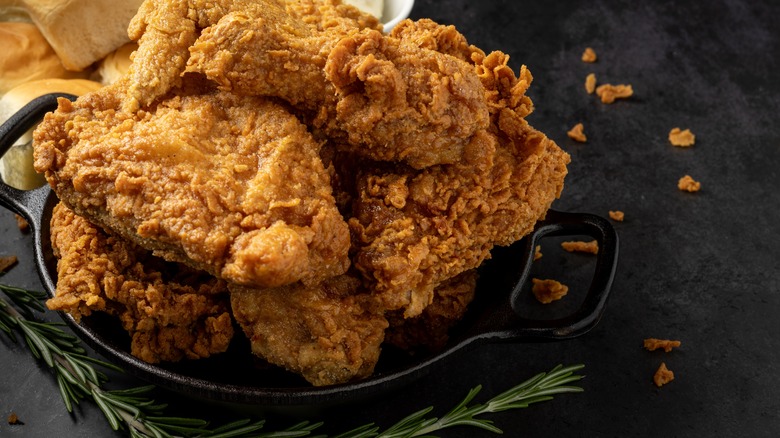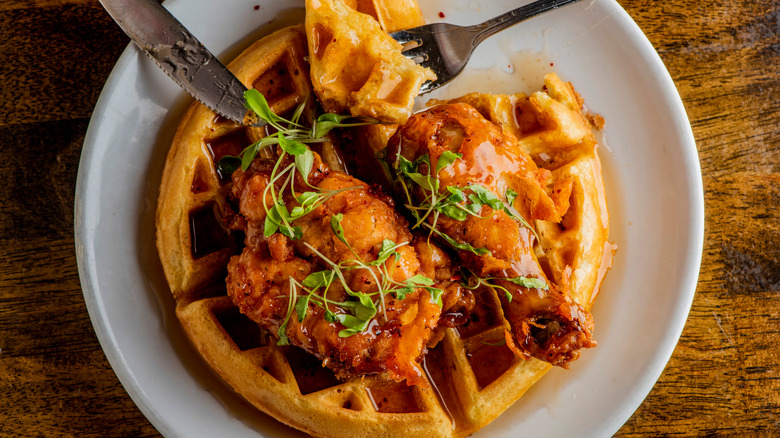13 Ways To Upgrade Fried Chicken
Fried chicken is one of those culinary items that feels impossible to make as well at home as they do in a professional restaurant kitchen. Luckily, there is plenty of guidance to be found on how to make the perfect homemade fried chicken. But what about tips for taking that plain Jane fried chicken to the next level? For that, we turned to some very special experts for inside intel.
Featuring tips from award-winning chefs and fried chicken connoisseurs, this article is all about how to add new flavors and use expert techniques to upgrade your fried chicken. We talk to one chef about their favorite breading, while another spills their tips on selecting the best oils for frying, and yet another shares some brining brilliance. In between, you'll learn how to best use a flavor injector, instant-read thermometers, and even the tried-and-true cast iron pan for your frying endeavors. By the end, you'll have more than a few new ideas to jump-start your deep-fried dreams.
Brine your chicken in sweet tea
Buttermilk is the standard liquid to brine your fried chicken in, but another tangy drink can fit the bill: The classic Southern sweet tea. This refreshing tip comes from Tasting Table's interview with Jeff McInnis, the chef behind the Arnold Palmer-style fried chicken you can find at Miami, Florida's Root & Bone restaurant. Taking inspiration from the Arnold Palmer's blend of sweet tea and lemonade, McInnis uses a blend of sweet tea and salt for a day-long marinade. What makes this such an excellent brining solution is that the tannins in the tea help tenderize the chicken while the sugar and salt help seal in that moisture.
To make your own sweet tea brine, start by making some sweet tea from scratch, boiling a kettle of tea, and adding a generous amount of sugar to the mix. From there, you'll stir in salt directly into the hot tea, making sure it dissolves completely. After that, you'll let your chicken brine in the sweet tea solution for at least a day, so the tea can work all of its tenderizing magic.
Allow your chicken to enjoy a long chill
A lot of chefs swear by the power of a brine, but one particular fried chicken connoisseur, William Dissen, owner and head chef at Billy D's Fried Chicken, told Mashed that the brine is only half of the equation. After a quick pickle brine, Dissen lets his chicken sit in the fridge for a while in the open air. Why? According to Dissen, "the outside [of] the chicken gets a little sticky, and so at that point, when you go to dredge it to deep fry it, that breading sticks on." This is courtesy of the pellicle, a sticky protein coat that forms during that open-air chill in the fridge.
To imitate this hack at home, give your chicken a fast soak in the brine, around 30 minutes. Then, pat your chicken dry and let it rest in the fridge on a drying rack placed over a sheet pan (the more surface area exposed to the air, the better). Let the chicken sit for 6 hours or overnight in the fridge. Afterward, you should have a chicken with a sticky exterior that'll properly hold its crispy coating.
Try white cornmeal for your crust
When it comes to the coating for fried chicken, each chef has a personal favorite, from cornflakes to ice cream cone crumbs. In an interview with Chowhound, Mackenzie Klyce, the co-owner and head chef at Velvet Pig in Mobile, Alabama, says her pick is white cornmeal for both superior crunch and a good color crust on your fried chicken. "If you use a white [cornmeal] it's gonna get less dark than if you use the yellow cornmeal," says Klyce.
If you want to make your own version of this cornmeal breading, follow Klyce's formula and use two parts cornmeal to one part all-purpose flour and one part cornstarch. While the flour helps provide a finer coating, the cornstarch makes the rest of the breading even crispier. Texturally speaking, you can use either fine or coarsely ground cornmeal, just note that one will give you a more substantial crunch than the other.
Use rice flour in the flour dredge
You can use more than just all-purpose flour for your fried chicken flour dredge. Rock Harper, a winner of "Hell's Kitchen" and the chef at Queen Mother's Fried Chicken, told Mashed that one of the secrets to his incredible fried chicken is the use of rice flour. Why? Rice flour provides a double benefit to fried chicken. First, it's gluten-free, which may be a huge help if you have dietary restrictions. Second, it makes for some of the crispiest fried chicken dishes you'll ever have. In fact, this is what makes popcorn chicken so crunchy.
"We use the rice flour because rice flour is lighter, crispier, not a surprise — but also, it absorbs less oil," Harper explains further. "The result is fried chicken that's juicy and not heavy." As Harper mentioned only using a little bit of rice flour in his breading, you could start by using a blend of rice flour and all-purpose flour in your chicken coating. To help this breading stick better, consider adding a dash of cornstarch as well. Once finished, you'll be on your way to a next-level batch of fried chicken.
Use milk bread breadcrumbs for your Katsu breading
If you're partial toward fried chicken coated with breadcrumbs, think about trading your typical batch of crumbs for something a little bit different. Chef Makoto Okuwa of Makoto Vail in Colorado told The Daily Meal that he likes to make his Katsu-style fried chicken with Japanese milk bread or shokupan breadcrumbs. Though this hack is directed specifically toward Okuwa's Katsu-style fried chicken, it could work just as well for other breadcrumb-coated fried chicken recipes. Makoto prefers dried milk bread crumbs as the bread itself has a "fluffiness and sweetness" which transfers beautifully into a breadcrumb mixture. Think of the lovely flavor combination of chicken and waffles and you can understand why a bit of sweetness goes a long way with fried chicken.
To make your own milk bread crumbs, start with buying a loaf (they're occasionally available at specialty stores and Asian markets) or making your own milk bread. Then, tear up the loaf into 1-inch pieces and bake at 300 degrees Fahrenheit for 15 minutes, or until completely dry. If you want the breadcrumbs finer, you can give them a quick blitz in the food processor, but otherwise, your crumbs are ready for breading.
Inject your chicken with spices
Looking to make your take your fried chicken in a spicier direction than Nashville Hot Chicken or Buffalo Chicken? Tik Tok foodie superstar Newt Nguyen told Mashed about another way for cooks to up the heat level of their fried chicken. For this tip, Nguyen calls out Jollibee for a great source of spicy fried chicken. What makes this spicy chicken special? As Nguyen notes, the spice is injected "into the chicken itself because, when you peel apart the breading, you see an injection mark and it's red."
A homemade take on this tip begins with getting a flavor injector, also known as a marinade injector. These are oversized, food-grade syringes that help pump marinades and sauces directly into your raw cuts of beef, chicken, or pork. In this case, you'd fill your injector with your favorite hot sauce or spiced oil and inject your chicken after frying it. This helps make it spicy without compromising the overall texture of the chicken.
Use duck fat for your frying oil
The tastiness of your fried chicken isn't solely dependent on your breading and brining. A lot of delicious flavor comes from the very oil it's fried in. According to a Mashed interview with chef Rock Harper of Queen Mother's Fried Chicken, duck fat is the best way to give your chicken superior flavor. "We fry in duck fat, which is premium fat and it makes the chicken taste way better," says Harper. Indeed, duck fat has been making every fried good, including potatoes, taste better for years.
If you're lucky enough to land a large batch of duck fat from your grocery store, you can use that, but it's possible for you to render your own duck fat at home. Start by purchasing a whole duck or duck breast and duck leg set. Next, you'll carefully trim all of the fat and skin from the bird and dice it up. In a large, heavy-bottom pot combine the skin, fat, and a ½ cup of water and simmer it for about 45 minutes to 1 hour, or until all the water has completely evaporated. Strain this rendered fat with a cheesecloth and place it in a jar where it can sit until you're ready to fry your next batch of chicken. Then, do yourself a favor and reuse whatever is leftover for a complimentary batch of potatoes.
Mix a blend of fats and oils for frying
Another great way to incorporate mind-blowing flavor into your fried chicken? Rely on a magical medley of fats and oils to fry your chicken. Sean Brock, a James Beard award-winning chef based in Nashville, Tennessee, advised Tasting Table that he uses an artisan blend of butter, schmaltz, lard, and ham fat to fry his chicken. "Bacon adds smoke, country ham adds funk, chicken echoes chicken, butter browns at the end and lard is the standard thing to fry chicken in," explains Brock.
Mackenzie Klyce told Chowhound that she also likes to use a blend of soybean oil and lard in her fryer. "We render our pork cracklings in our fryer, so our fryer is going to be a soy oil with lard in it," she notes. To make your own frying blend, you can begin by collecting leftover bacon drippings from your breakfast or saving the chicken drippings from your most recent roasted chicken. You can also buy specialty rendered fat at the grocery store, like canned tallow or lard. You can blend these stronger fats with a more neutral oil, like soybean oil or peanut oil, letting the fats flavor while the oil makes up the bulk of the frying liquid.
Keep the oil temperature steady
For the first time fryer, temperature may seem the most unimportant detail, but seasoned fried chicken cooks know differently. Frying at the correct temperature determines whether your chicken is crispy or soggy, burnt or just golden. Chef Mackenzie Klyce mentioned to Chowhound that she likes to keep her oil at 325 degrees Fahrenheit for bone-in fried chicken, and no higher than 350 degrees Fahrenheit for all other fried chicken recipes. Chef Jeff McInnis told Tasting Table that he is also big on keeping the oil temperature steadily at 325 degrees Fahrenheit, as the chicken will not be crispy if the temp drops too low. However, he also notes that during the frying process, the temperature will inevitably dip, so he suggests starting by heating your oil to a higher temperature, around 365 degrees Fahrenheit.
So how should you keep a watchful eye on your oil temperature? Invest in an instant-read food thermometer, preferably one with a clip that you can use to secure to the side of your frying vessel. This will help you know what temp your oil is at throughout the cooking process. A meat thermometer would also be helpful, as you can then tell when your chicken is done (properly cooked chicken should register at 165 degrees Fahrenheit).
Fry room temperature chicken
Speaking of temperature, there's another item you should be checking religiously, other than the oil. According to a Tasting Table interview with Richard Hales, the executive chef of the now-closed Bird & Bone restaurant in Miami, you also need to make sure your chicken is at room temperature before introducing it into the fryer. Why? An ice-cold piece of chicken will never cook properly in a bath of hot oil. The exterior will get expertly crispy but the interior will stay raw. In addition, it'll lower the oil temperature so you're other chicken cuts will also struggle to fry up.
To ensure that your chicken is at room temperature, remove it from the fridge at least 20 to 30 minutes before frying. You should also try to get the liquid element of your coating to room temperature, so let your milk, eggs, or water sit out for around 30 minutes as well. If you get the temp right, you should have no issue cooking your fried chicken in a flash.
Double-fry your chicken
Flavor is an important element of fried chicken, but some people are completely devoted to the cult of the crunch. Stephen Parker of Black Tap Craft Burgers & Beers told The Daily Meal the top tip for those who prize crispiness above all other factors. His idea? Two fries are better than one. Parker claims his restaurant's chicken wings double deep fry is what makes them so divinely crisp.
To double fry your chicken, start with a lower temperature fry, between 300 degrees Fahrenheit and 325 degrees Fahrenheit. After this initial fry, Parker lets the chicken rest for at least 15 to 20 minutes. In fact, a busy chef can even pop their once-fried wings in the fridge and finish the second fry the next day. For the second deep fry, Parker shoots for a much higher temperature, 350 degrees Fahrenheit to 400 degrees Fahrenheit, and fries the chicken for a much shorter amount of time, only a few minutes. Though this tip is used specifically for chicken wings, it can be used for other cuts of fried chicken as well.
Fry in a cast iron pan
Let's be honest; home chefs don't always have access to the professional equipment that expert chefs have. That often includes a dedicated deep fryer, but Bob Bennet of Zingerman's Roadhouse told The Daily Meal, you don't need a deep fryer to make proper fried chicken. Instead, shoot for using a cast iron pan or Dutch oven. According to Bennet, "[Cast iron and Dutch ovens] hold the heat really well for fried foods." As keeping a steady temp is crucial to making quality fried chicken, this makes cast iron pans the way to go.
When picking your pan, make sure you're either using a proper Dutch oven or a skillet with tall enough rims to keep splatters from happening. For frying, it makes little difference whether it's enamel-coated or seasoned cast iron. The enamel coating is only necessary to keep food from sticking to the bottom — not necessarily an issue when you're deep frying. Keep in mind that cast iron pans hold heat even in their handles, so make sure to have oven mitts on hand if you plan to move the pan around.
Finish you chicken with sweet, salty, and spicy flavors
Sometimes, a quality piece of fried chicken is all about the finishing touches. For Mackenzie Klyce, those finishing touches come in the form of a triple threat of flavoring. First, she coats her fried pieces in a salty in-house seasoning blend. Then she drizzles on Steen's Cane Syrup, a classic, mild syrup from Louisiana. Finally, she pairs her chicken with a Tabasco hot sauce dip. This holy trinity of flavors makes the fried chicken taste perfectly nuanced.
To make this hack your own, consider incorporating your favorite salty seasoning blend, like an herbaceous Ranch dressing blend or a plain garlic salt seasoning. Next, pick a syrup that you think would complement the chicken. Maple is an obvious candidate, as it calls to mind traditional chicken and waffles, but date syrup could offer a delicious departure. Finally, think of what kind of hot sauce would round out the rest of the flavor. A vinegar-based hot sauce could bring both tang and heat, while a chipotle-style hot sauce could bring a smoky quality to the dish.
Static Media owns and operates Chowhound, The Daily Meal, Mashed, and Tasting Table.
